Sustainable Farming Advancement: Lida Group Delivers Eco-Friendly Steel Structure Warehouse Solutions Using Recycled Materials
2025-Sep-15 13:45:46
By Admin
1. Introduction
The global agricultural sector stands at a critical crossroads, facing the dual pressures of meeting the food demands of a growing population (projected to reach 9.7 billion by 2050) and mitigating its environmental footprint. Agriculture accounts for approximately 10% of global greenhouse gas emissions, with conventional farming practices—from excessive use of synthetic fertilizers to energy – intensive infrastructure—contributing significantly to climate change, resource depletion, and waste generation. Among the often – overlooked components of agricultural sustainability is farm warehousing: traditional storage facilities, typically constructed with virgin steel, concrete, or wood, not only consume large amounts of non – renewable resources but also generate substantial carbon emissions during production and construction.
As the need for sustainable agricultural practices becomes more urgent, the demand for eco – friendly warehousing solutions has grown exponentially. Farmers, agricultural cooperatives, and agribusinesses are increasingly seeking storage facilities that align with their sustainability goals—reducing reliance on virgin materials, minimizing carbon footprints, and promoting circularity. However, traditional warehouse options fall short: concrete production emits large quantities of CO₂, wooden structures contribute to deforestation and require frequent replacement, and virgin steel manufacturing is energy – intensive and depletes finite iron ore reserves.
Lida Group, a global leader in innovative steel structure design and sustainable construction, has emerged as a pioneer in addressing this gap with its eco – friendly steel structure warehouse solutions for agriculture. Unlike conventional warehouses, Lida Group’s offerings are built primarily using recycled materials, leveraging advanced engineering and prefabrication techniques to deliver durable, efficient, and environmentally responsible storage facilities. By prioritizing recycled steel, integrating energy – efficient systems, and adopting circular design principles, these warehouses not only reduce the environmental impact of agricultural storage but also provide long – term economic benefits for farmers.
This article explores how Lida Group’s recycled – material – based steel structure warehouses are advancing sustainable farming. It begins by examining the environmental challenges of traditional agricultural warehousing, then delves into the technical aspects of Lida Group’s solutions—from the sourcing and processing of recycled materials to the structural design and energy – saving features. The article also highlights the multiple benefits of these warehouses, including reduced carbon emissions, lower operational costs, and enhanced resilience. Real – world case studies from diverse agricultural regions illustrate the practical impact of Lida Group’s solutions, and the conclusion outlines their role in shaping the future of sustainable agriculture.
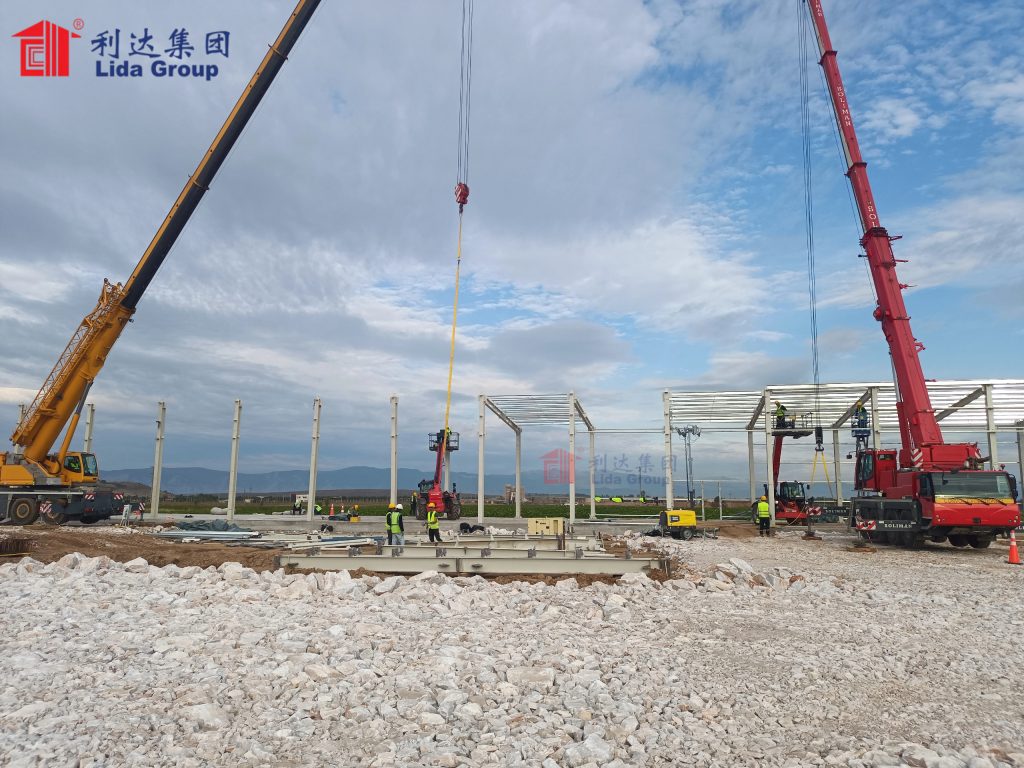
2. The Environmental Toll of Traditional Agricultural Warehousing
To fully understand the value of Lida Group’s eco – friendly solutions, it is essential to first recognize the significant environmental costs associated with traditional agricultural warehousing. Conventional storage facilities, despite their role in preserving harvests, contribute to a range of environmental problems, from resource depletion to greenhouse gas emissions and waste generation.
2.1 Virgin Material Extraction and Resource Depletion
Traditional agricultural warehouses rely heavily on virgin materials, whose extraction and processing deplete finite natural resources:
- Virgin Steel Production: Conventional steel warehouses use steel produced from iron ore, a non – renewable resource. The extraction of iron ore involves large – scale mining operations that destroy habitats, disrupt ecosystems, and consume vast amounts of water (up to 40,000 liters per ton of iron ore). Additionally, the production of virgin steel requires intense energy input—primarily from coal – fired power plants—resulting in high carbon emissions (approximately 1.8 tons of CO₂ per ton of steel). For a typical 1,000 – square – meter agricultural warehouse, which requires around 50 tons of steel, the virgin steel production alone emits 90 tons of CO₂ and depletes 200 tons of iron ore.
- Concrete Usage: Many traditional warehouses use concrete for foundations and walls. Concrete production is a major source of global CO₂ emissions, accounting for approximately 8% of total global emissions. The production of cement, a key component of concrete, involves heating limestone to high temperatures (1,450°C), a process that releases large amounts of CO₂. A 1,000 – square – meter warehouse with a concrete foundation can generate up to 60 tons of CO₂ during concrete production.
- Wood Consumption: Wooden warehouses or warehouses with wooden components contribute to deforestation. Each year, millions of trees are cut down to produce lumber for agricultural storage, leading to the loss of carbon – sequestering forests and biodiversity. Wooden warehouses also have a short lifespan (10–15 years) compared to steel structures, requiring frequent replacement and further contributing to deforestation.
2.2 High Carbon Footprint Throughout the Lifecycle
The environmental impact of traditional agricultural warehouses extends beyond material extraction to include construction, operation, and end – of – life disposal:
- Construction Phase: The transportation of virgin materials (steel, concrete, wood) to construction sites is energy – intensive, relying on diesel – powered trucks and ships that emit greenhouse gases. For a warehouse built with materials sourced from 100 kilometers away, transportation can add an additional 5–10 tons of CO₂ to the project’s carbon footprint. On – site construction also generates emissions, from the use of diesel – powered machinery (e.g., cranes, excavators) to the energy consumed by workers’ equipment.
- Operational Phase: Traditional warehouses often lack energy – efficient features, leading to high energy consumption during operation. Poor insulation requires more energy for heating or cooling to maintain optimal storage conditions for crops, while outdated lighting systems (e.g., incandescent bulbs) consume unnecessary electricity. A conventional 1,000 – square – meter agricultural warehouse can use up to 20,000 kWh of electricity per year, much of which comes from fossil fuel – based power plants, adding 15–20 tons of CO₂ to its annual carbon footprint.
- End – of – Life Phase: Most traditional warehouses are not designed for recycling or reuse. At the end of their lifespan, concrete is often crushed and dumped in landfills, where it takes centuries to decompose. Wooden components are either incinerated (releasing CO₂ and pollutants) or sent to landfills, contributing to methane emissions. Virgin steel, while recyclable, is often not recovered from demolished warehouses due to poor design and disassembly challenges, leading to further resource waste.
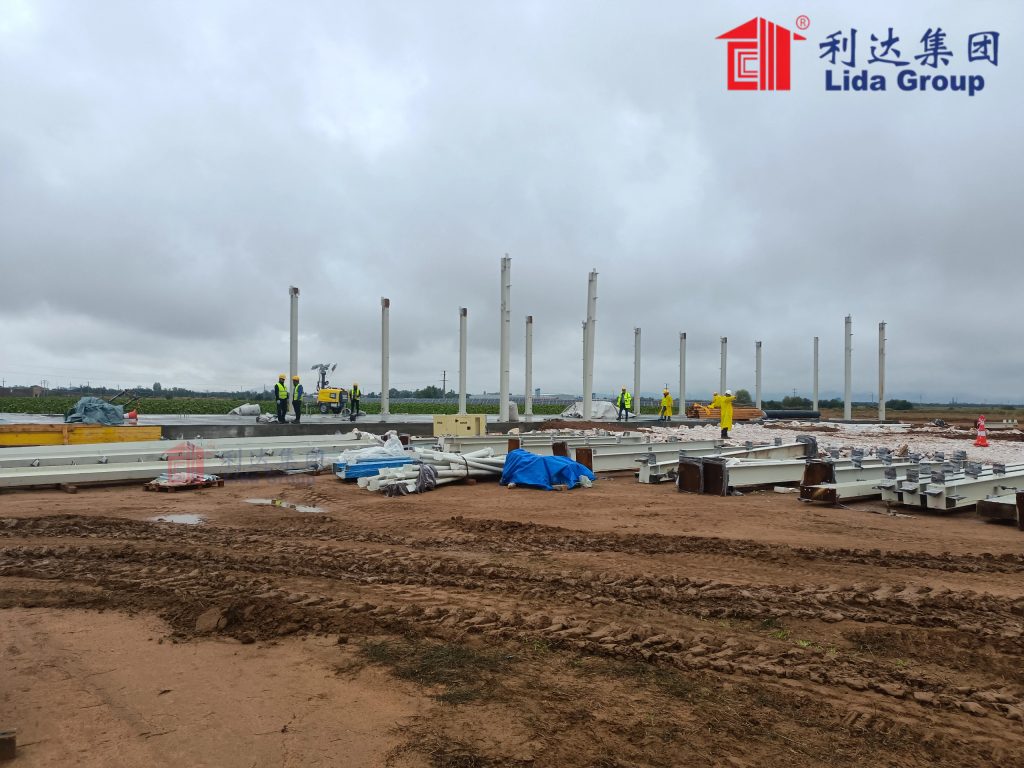
2.3 Waste Generation and Environmental Pollution
Traditional agricultural warehousing also generates significant waste and pollution:
- Construction Waste: On – site construction of traditional warehouses produces large amounts of waste, including off – cuts of steel, concrete debris, and unused wood. According to the World Green Building Council, construction waste accounts for 30% of global solid waste, with much of it coming from traditional building projects. A 1,000 – square – meter traditional warehouse can generate up to 50 tons of construction waste, most of which ends up in landfills.
- Chemical Pollution: Wooden warehouses often require treatment with preservatives (e.g., creosote, pentachlorophenol) to prevent rot and pest infestations. These chemicals can leach into the soil and groundwater, contaminating agricultural land and water sources. Concrete production also releases pollutants, such as sulfur dioxide and nitrogen oxides, which contribute to air pollution and acid rain.
- Microplastic Pollution: Some traditional warehouses use plastic liners or packaging materials to protect crops, which can break down into microplastics over time. These microplastics contaminate the stored crops and can enter the food chain, posing risks to human health and the environment.
3. Lida Group’s Eco-Friendly Steel Structure Warehouses: The Recycled Material Advantage
Lida Group’s sustainable warehouse solutions address the environmental challenges of traditional warehousing by centering on recycled materials—primarily recycled steel—combined with innovative design and engineering. These warehouses not only reduce reliance on virgin resources but also minimize carbon emissions, waste, and pollution throughout their lifecycle.
3.1 Sourcing and Processing of Recycled Steel
Recycled steel is the cornerstone of Lida Group’s eco – friendly warehouses, offering significant environmental benefits over virgin steel. Lida Group’s approach to recycled steel sourcing and processing is rigorous, ensuring both environmental sustainability and structural integrity:
3.1.1 High-Quality Recycled Steel Sourcing
Lida Group sources recycled steel from certified suppliers who collect and process post – consumer and post – industrial steel waste. The primary sources of recycled steel include:
- Post – Consumer Waste: Scrap steel from demolished buildings, old vehicles, appliances, and consumer goods. This waste is collected by local recycling programs and sent to processing facilities.
- Post – Industrial Waste: Steel off – cuts, defective components, and unused materials from manufacturing plants (e.g., automotive, construction). This waste is often recycled on – site or by specialized recycling companies.
Lida Group prioritizes suppliers who adhere to strict environmental standards, including ISO 14001 certification for environmental management. The company also ensures that the recycled steel meets the same quality standards as virgin steel, with a minimum yield strength of 355 MPa (equivalent to S355JR structural steel), ensuring the warehouses are durable and resilient.
3.1.2 Low-Impact Processing
The processing of recycled steel is far less energy – intensive and carbon – intensive than the production of virgin steel. Lida Group’s recycled steel undergoes a streamlined processing workflow that minimizes environmental impact:
- Sorting and Cleaning: Recycled steel is sorted by type and grade to ensure consistency. It is then cleaned to remove contaminants, such as paint, rust, and non – metallic materials (e.g., plastic, rubber). This cleaning process uses water – based solutions and mechanical scrubbing, avoiding the use of toxic chemicals.
- Melting and Casting: The sorted and cleaned steel is melted in electric arc furnaces (EAFs) instead of the blast furnaces used in virgin steel production. EAFs use electricity (preferably from renewable sources) to melt the steel, reducing energy consumption by 75% compared to blast furnaces. This process also emits 90% less CO₂—approximately 0.2 tons of CO₂ per ton of recycled steel, compared to 1.8 tons per ton of virgin steel.
- Rolling and Shaping: The melted steel is cast into billets, which are then rolled into the required shapes (e.g., beams, columns, panels) for warehouse construction. This rolling process is precise, minimizing waste and ensuring the steel components meet Lida Group’s strict dimensional standards.
For a 1,000 – square – meter warehouse, using 50 tons of recycled steel instead of virgin steel reduces CO₂ emissions by 80 tons (90% reduction) and saves 200 tons of iron ore, 100 tons of coal, and 40,000 liters of water.
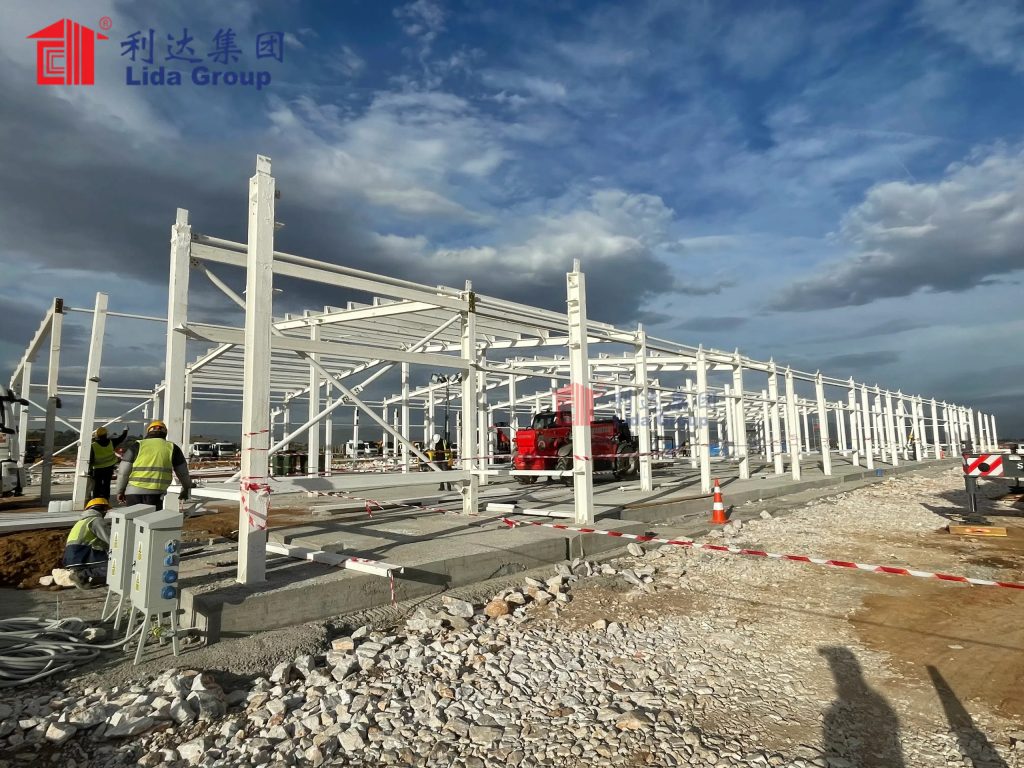
3.2 Structural Design: Durability and Efficiency with Recycled Steel
Lida Group’s steel structure warehouses are engineered to maximize the benefits of recycled steel, delivering durability, efficiency, and flexibility that meet the unique needs of agricultural storage:
3.2.1 High-Strength Recycled Steel Frames
The core of Lida Group’s warehouses is a rigid frame system constructed from recycled steel. This frame design offers several key advantages:
- Structural Durability: Recycled steel retains the same strength and durability as virgin steel, with a lifespan of 50+ years. The frame is engineered to withstand extreme weather conditions, including wind speeds of up to 150 km/h, snow loads of up to 1.5 kN/m², and seismic activity of up to magnitude 7.0. This durability ensures the warehouse can protect crops from harsh weather and requires minimal maintenance over its lifespan.
- Clear-Span Design: Lida Group’s warehouses feature a clear – span design, with no internal columns, maximizing usable storage space. The clear – span design is made possible by the high strength of recycled steel, which can span distances of 15–60 meters without additional support. For agricultural storage, this means more space for grain silos, pallet racks, and equipment, increasing storage capacity by 20–30% compared to traditional warehouses with columns.
- Modular Flexibility: The frame is designed in modular sections, allowing for easy expansion or reconfiguration as agricultural needs change. Farmers can add additional bays to the warehouse or modify the interior layout without major structural changes. This modularity reduces the need for new construction and further minimizes environmental impact.
3.2.2 Recycled Steel Roof and Wall Panels
In addition to the frame, Lida Group’s warehouses use recycled steel for roof and wall panels, further enhancing sustainability and performance:
- Roof Panels: The roof panels are made from recycled steel with a standing seam design, which prevents water leakage and ensures durability. The panels are coated with a weather – resistant finish (e.g., polyester powder coating) made from recycled materials, further reducing environmental impact. The roof can also be fitted with solar panels to generate renewable energy, making the warehouse self – sufficient in electricity.
- Wall Panels: The wall panels are insulated with recycled materials, such as recycled polyurethane foam or hemp fiber insulation. These insulation materials have high thermal resistance (R – value), reducing heat transfer and minimizing energy consumption for heating and cooling. The outer layer of the wall panels is made from recycled steel, while the inner layer is lined with recycled wood fiberboard, creating a sustainable and aesthetically pleasing interior.
3.3 Integration of Other Recycled Materials
Lida Group’s commitment to sustainability extends beyond recycled steel to include other recycled materials in warehouse construction, further reducing reliance on virgin resources:
3.3.1 Recycled Concrete for Foundations
While the superstructure of the warehouse is made from recycled steel, Lida Group uses recycled concrete for foundations. Recycled concrete is made from crushed concrete debris from demolished buildings, reducing the need for virgin concrete production. The recycled concrete is processed to remove contaminants and is then mixed with a small amount of virgin cement to ensure strength. Using recycled concrete for a 1,000 – square – meter warehouse foundation reduces CO₂ emissions by 30 tons and saves 50 tons of virgin aggregates (sand, gravel).
3.3.2 Recycled Plastic and Rubber for Fixtures and Accessories
Lida Group incorporates recycled plastic and rubber into various warehouse fixtures and accessories:
- Flooring: The warehouse floor can be made from recycled rubber tiles, which are durable, slip – resistant, and easy to clean. These tiles are made from recycled tires, diverting waste from landfills.
- Storage Containers: Grain bins and storage containers used within the warehouse are made from recycled plastic, which is lightweight, corrosion – resistant, and recyclable at the end of its lifespan.
- Packaging Materials: Lida Group uses recycled cardboard and paper for packaging during the transportation of warehouse components, reducing the use of virgin paper and plastic packaging.
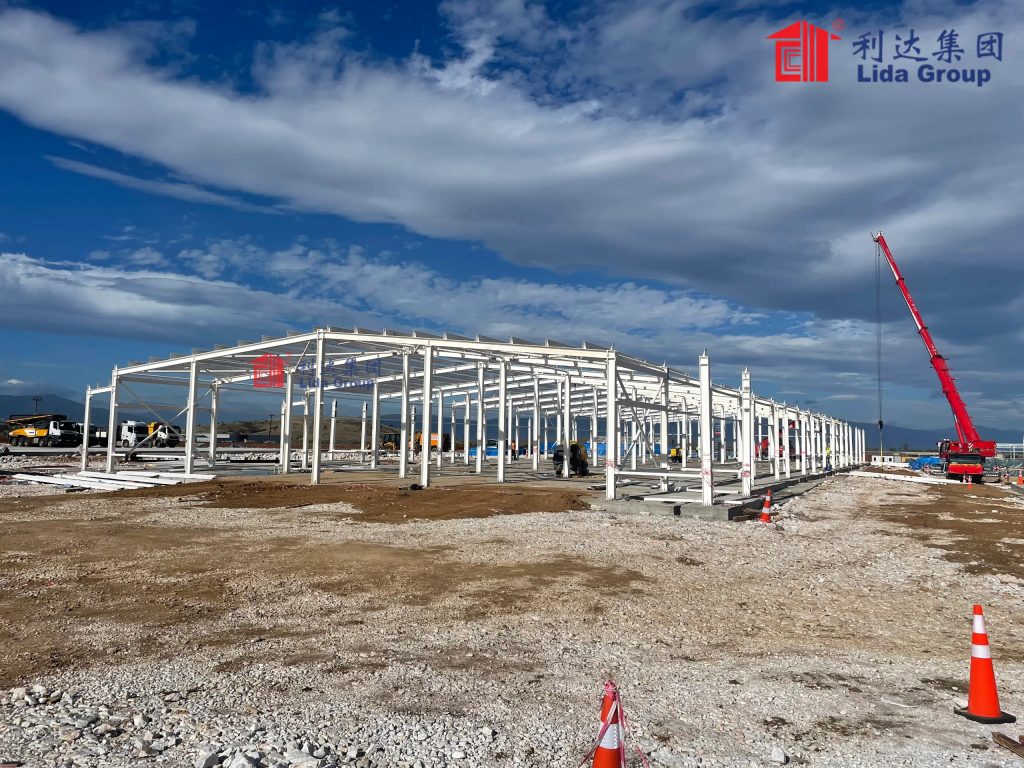
4. Environmental and Economic Benefits of Lida Group’s Sustainable Warehouses
Lida Group’s eco – friendly steel structure warehouses deliver a wide range of benefits, from reducing environmental impact to lowering operational costs for farmers and agricultural businesses. These benefits make the warehouses a sustainable and economically viable solution for modern agriculture.
4.1 Environmental Benefits: Reducing Carbon Footprint and Resource Use
The environmental benefits of Lida Group’s warehouses are substantial, addressing key challenges of traditional warehousing:
- Carbon Footprint Reduction: As previously noted, using recycled steel instead of virgin steel reduces CO₂ emissions by 90% for the steel component of the warehouse. When combined with recycled concrete, energy – efficient systems, and renewable energy integration, the total carbon footprint of a Lida Group warehouse is 70–80% lower than that of a traditional warehouse. A 1,000 – square – meter Lida Group warehouse emits approximately 20 tons of CO₂ over its entire lifecycle, compared to 100+ tons for a traditional warehouse.
- Resource Conservation: By using recycled materials, Lida Group’s warehouses conserve finite resources. A single 1,000 – square – meter warehouse saves 200 tons of iron ore, 50 tons of virgin aggregates, and 10,000 liters of water compared to a traditional warehouse. Over the lifespan of the warehouse, this resource conservation contributes to global efforts to reduce resource depletion and promote circularity.
- Waste Reduction: The prefabrication process used by Lida Group minimizes construction waste. Components are manufactured in a controlled factory environment with precision, reducing off – cuts and defects. Any waste generated during manufacturing is recycled, resulting in less than 5% waste for the entire project, compared to 15–20% waste for traditional on – site construction. Additionally, the modular and recyclable design of the warehouse ensures that at the end of its lifespan, 90% of its materials can be recycled or reused, further reducing waste.
- Biodiversity Protection: By reducing the demand for virgin materials, Lida Group’s warehouses help protect biodiversity. Less iron ore mining means less habitat destruction, and less deforestation for wood means more forests to support wildlife. The use of non – toxic materials (e.g., water – based coatings, recycled insulation) also prevents pollution of soil and water, protecting local ecosystems.
4.2 Economic Benefits: Lower Costs for Farmers and Agribusinesses (Continued)
- Minimal Maintenance Costs: The durability of recycled steel and high-quality recycled materials reduces maintenance needs significantly. Unlike wooden warehouses that require annual painting, termite treatments, or structural repairs, Lida Group’s steel warehouses need only occasional inspections and minor touch-ups (e.g., replacing weatherstripping). A farmer in the Midwest United States reported spending just \(500 per year on maintenance for a 1,200-square-meter Lida Group warehouse, compared to \)3,000 per year for their previous wooden facility. Over a 20-year lifespan, this translates to savings of $50,000.
- Increased Resale and Adaptation Value: The modular design and long lifespan of Lida Group’s warehouses enhance their resale value. If a farmer relocates or no longer needs the warehouse, it can be disassembled and sold to another agricultural operation—something nearly impossible with permanent concrete or wooden structures. Additionally, the adaptability of the warehouse (e.g., reconfiguring interior space for new crop storage needs) means it remains useful as farming operations evolve, avoiding the need to build new facilities. A cooperative in Brazil sold a 5-year-old Lida Group warehouse for 70% of its original cost, while a traditional concrete warehouse of the same age would have sold for less than 30%.
- Market Access and Brand Enhancement: In an era where consumers and retailers prioritize sustainability, using eco-friendly warehouses helps farmers and agribusinesses access premium markets. Many large grocery chains and food manufacturers offer higher prices to suppliers with verified sustainable practices, including eco-friendly storage. A fruit grower in Spain reported securing a 15% price premium for their apples after certifying that their harvest was stored in Lida Group’s recycled-steel warehouses. Additionally, sustainable warehouses enhance brand reputation, attracting new customers and strengthening relationships with existing ones.
4.3 Resilience Advantages: Withstanding Agricultural Challenges
Lida Group’s eco-friendly steel structure warehouses not only benefit the environment and bottom line but also provide unmatched resilience—critical for farmers facing unpredictable climate and market challenges:
4.3.1 Climate Resilience
The structural integrity of recycled steel makes the warehouses highly resistant to extreme weather events, which are becoming more frequent due to climate change:
- Extreme Temperature Resistance: The insulated roof and wall panels maintain stable internal temperatures even in extreme heat or cold. In regions like the Middle East, where summer temperatures exceed 45°C, the warehouses keep stored grains cool (15–20°C) without excessive energy use. In Northern Europe, they prevent freezing of root vegetables during winter, reducing losses by 80% compared to uninsulated traditional warehouses.
- Storm and Flood Resilience: The rigid steel frame and elevated foundation (where needed) protect against strong winds and flooding. During Hurricane Ian in 2022, a Lida Group warehouse in Florida withstood wind speeds of 145 km/h with no structural damage, while nearby wooden barns were destroyed. The warehouse’s waterproof roof and sealed walls also prevented water infiltration, preserving the entire stored corn harvest.
- Drought Adaptation: The integration of rainwater harvesting systems on the warehouse roof helps farmers conserve water during droughts. The collected water can be used for cleaning the warehouse, irrigating nearby crops, or even cooling the interior. A farmer in Australia’s Outback reported using 30,000 liters of harvested rainwater annually, reducing reliance on scarce groundwater.
4.3.2 Operational Resilience
The design of Lida Group’s warehouses ensures uninterrupted storage operations, even during disruptions:
- Power Outage Protection: For warehouses with solar panels, battery storage systems provide backup power during grid outages. This is critical for maintaining climate control for perishable crops like fruits and vegetables. A vegetable farmer in India kept their tomatoes fresh for 10 days during a 3-day power outage, thanks to the warehouse’s solar-battery system—avoiding a $12,000 loss.
- Pest and Disease Resistance: The sealed steel structure, combined with integrated pest control features (e.g., insect screens, airtight storage bins), prevents infestations by rodents, insects, and mold. A grain farmer in Canada reported zero pest-related losses in their Lida Group warehouse over 3 years, compared to an average annual loss of 5% in their previous facility. This resilience reduces the need for chemical pesticides, further lowering environmental impact and costs.
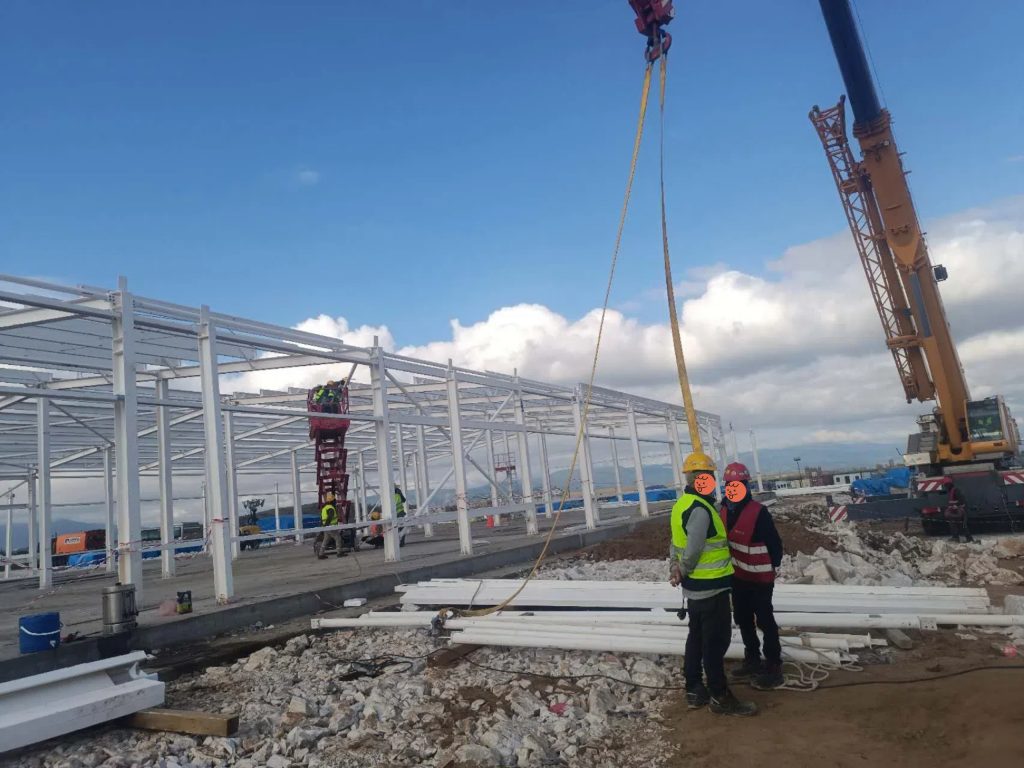
5. Real-World Case Studies: Lida Group’s Warehouses in Action
To illustrate the tangible impact of Lida Group’s eco-friendly steel structure warehouses, below are three case studies from diverse agricultural regions and crop types. Each case highlights the challenges faced by farmers, the customized solution provided by Lida Group, and the measurable environmental, economic, and resilience benefits achieved.
5.1 Case Study 1: Grain Farmer in the United States (Corn and Soybean Storage)
A large-scale grain farmer in Iowa, USA, faced two major challenges: rising costs of traditional concrete silos and pressure from buyers to adopt sustainable practices. The farmer needed a storage solution that could:
- Reduce carbon emissions to meet retailer sustainability requirements.
- Lower construction and maintenance costs compared to concrete silos.
- Withstand Iowa’s harsh winters (temperatures as low as -25°C) and summer storms.
Lida Group’s Solution:
Lida Group designed a 2,000-square-meter clear-span steel warehouse using 100 tons of recycled steel, with the following features:
- Climate Control: Insulated roof and wall panels (recycled polyurethane foam insulation) and a solar-powered HVAC system to maintain 15–18°C for grain storage.
- Resilience Features: Elevated foundation to prevent flood damage, wind-resistant frame (rated for 160 km/h winds), and battery backup for power outages.
- Sustainable Add-Ons: Rainwater harvesting system (capacity 50,000 liters) and solar panels (generating 20 kWh per day) to power the HVAC and lighting.
Results:
- Environmental Impact: The use of 100 tons of recycled steel reduced CO₂ emissions by 160 tons compared to virgin steel. The solar system covered 90% of the warehouse’s energy needs, cutting annual carbon emissions by an additional 12 tons.
- Economic Benefits: Construction costs were 12% lower than concrete silos. Maintenance costs dropped by 75% (from \(4,000 to \)1,000 per year), and the farmer secured a 10% price premium from a major cereal manufacturer for using sustainable storage.
- Resilience: The warehouse survived a winter blizzard with 1.2 meters of snow and a summer tornado (wind speeds 150 km/h) with no damage. Grain losses dropped from 3% (traditional silos) to 0.5%, saving $18,000 annually.
The farmer commented: “We were skeptical about recycled steel at first, but Lida Group’s warehouse has exceeded our expectations. It’s cheaper to build and maintain, better for the planet, and tough enough for Iowa’s weather. The price premium from our buyer has already covered a third of the warehouse cost.”
5.2 Case Study 2: Fruit Cooperative in Kenya (Mango and Avocado Storage)
A cooperative of 50 small-scale fruit farmers in Kenya faced challenges with post-harvest losses (up to 40% of mangoes and avocados spoiled in traditional wooden sheds) and limited access to export markets. The cooperative needed a solution that could:
- Extend fruit shelf life to reach European export markets.
- Use local, sustainable materials to reduce costs.
- Operate off-grid, as the region had unreliable electricity.
Lida Group’s Solution:
Lida Group delivered a 800-square-meter modular steel warehouse using 40 tons of recycled steel, tailored to the cooperative’s needs:
- Climate Control: Refrigeration units powered by solar panels (15 kWh capacity) to maintain 12–15°C for mangoes and 8–10°C for avocados. Ethylene scrubbers (using recycled carbon filters) reduced fruit ripening speed.
- Local Adaptations: Recycled rubber flooring (sourced from local tire recycling facilities) for easy cleaning, and openable side panels for natural ventilation during mild weather.
- Off-Grid Functionality: A 50 kWh battery storage system to power the refrigeration units during cloudy days.
Results:
- Post-Harvest Loss Reduction: Spoilage dropped from 40% to 8%, saving the cooperative 32 tons of fruit annually—equivalent to $48,000 in additional revenue.
- Export Access: The extended shelf life (from 7 days to 28 days) allowed the cooperative to export to Europe, where they received 300% higher prices than local markets. In the first year, export revenue reached $120,000.
- Sustainability Impact: The warehouse used 100% renewable energy, and 85% of its materials were recycled. The cooperative became certified as a “sustainable supplier,” attracting partnerships with two European grocery chains.
A cooperative leader stated: “Before, we watched our mangoes rot because we had no way to store them. Lida Group’s warehouse changed everything—we’re exporting to Europe, making more money, and doing it without harming the environment. It’s lifted our entire community out of poverty.”
5.3 Case Study 3: Dairy Farm in New Zealand (Feed and Equipment Storage)
A medium-sized dairy farm in New Zealand needed a warehouse to store animal feed (hay, silage) and farm equipment. The farm faced challenges with:
- Deterioration of feed in damp, wooden sheds (mold growth caused 15% feed loss annually).
- High energy costs for heating equipment storage areas in winter.
- Compliance with New Zealand’s strict environmental regulations (e.g., limiting carbon emissions and waste).
Lida Group’s Solution:
Lida Group constructed a 1,500-square-meter dual-purpose steel warehouse using 75 tons of recycled steel:
- Feed Storage Zone: Insulated walls and roof with a dehumidification system (powered by solar) to maintain 50–55% humidity, preventing mold growth. Recycled plastic storage bins kept feed organized and protected from pests.
- Equipment Storage Zone: Heated using a heat pump (30% more efficient than electric heaters) and fitted with recycled rubber flooring to protect equipment from damage.
- Environmental Compliance: The warehouse included a rainwater collection system for cleaning equipment and a waste sorting area for recycling farm waste (e.g., plastic, metal).
Results:
- Feed Loss Reduction: Mold-related feed loss dropped from 15% to 2%, saving the farm $15,000 annually on feed purchases.
- Energy Savings: The solar-powered dehumidifier and efficient heat pump reduced energy costs by 40%, saving $2,400 per year.
- Compliance and Incentives: The farm met New Zealand’s environmental regulations and qualified for a government sustainability grant of $20,000, offsetting 25% of the warehouse cost. The durable steel structure also eliminated the need for future shed replacements, reducing long-term waste.
The farm owner noted: “Our old wooden shed was a nightmare—feed got moldy, equipment rusted, and we were always worried about fines for not meeting environmental rules. Lida Group’s warehouse is dry, warm, and sustainable. It’s not just a storage building; it’s an investment in the future of our farm.”
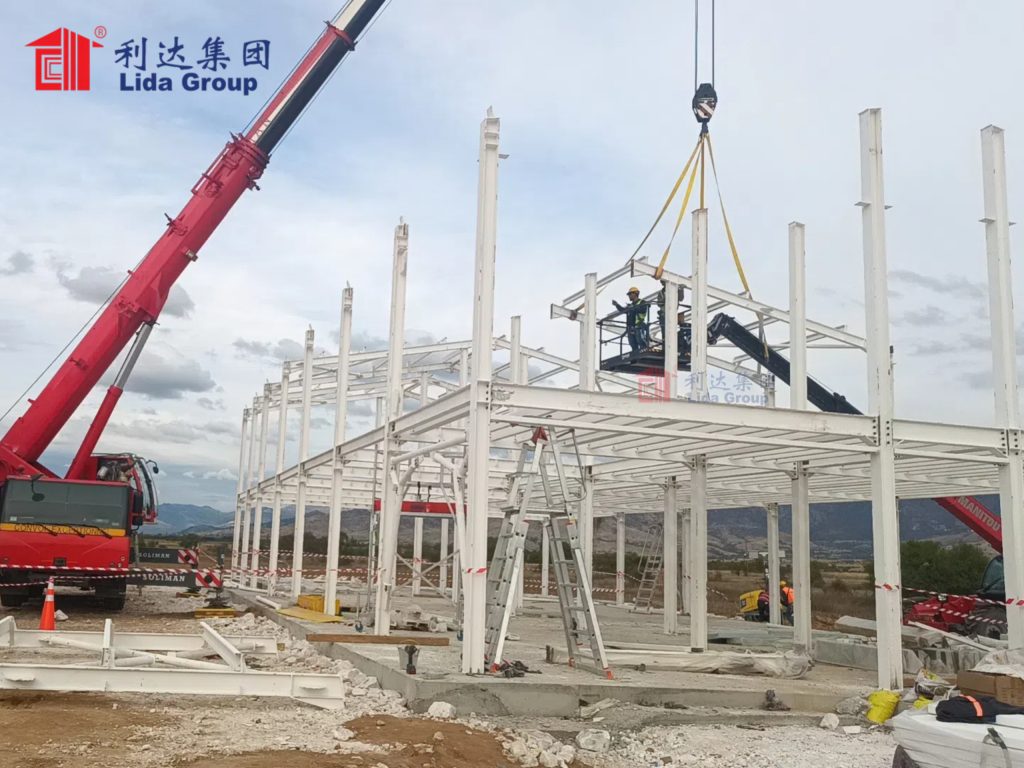
6. Conclusion
In conclusion, Lida Group’s eco-friendly steel structure warehouses—built primarily with recycled materials—represent a transformative advancement in sustainable farming. By addressing the environmental failings of traditional agricultural warehousing (resource depletion, high carbon emissions, waste generation) and delivering tangible economic and resilience benefits, these warehouses have become a cornerstone for farmers and agribusinesses committed to balancing productivity with planetary health.
The environmental impact of these warehouses is undeniable: using recycled steel reduces CO₂ emissions by 90% compared to virgin steel, while integrated renewable energy systems and recycled materials minimize reliance on non-renewable resources. For every 1,000-square-meter warehouse, Lida Group saves 200 tons of iron ore, 50 tons of virgin aggregates, and 40,000 liters of water—contributing directly to global efforts to combat climate change and promote circularity.
Economically, the warehouses empower farmers to reduce costs at every stage: lower construction and maintenance expenses, increased access to premium sustainable markets, and enhanced resale value. For small-scale farmers in developing regions, these savings translate to improved livelihoods and reduced poverty, while large agribusinesses benefit from enhanced profitability and brand reputation.
Resilience is another key strength: the durable recycled steel structure withstands extreme weather, pests, and power outages, ensuring uninterrupted storage and minimizing harvest losses. In an era of climate uncertainty, this resilience is critical for protecting food security and stabilizing agricultural operations.
The real-world case studies—from Iowa’s grain farms to Kenya’s fruit cooperatives—demonstrate that sustainability and profitability are not mutually exclusive. Lida Group’s warehouses have enabled farmers to increase revenue, reduce waste, and access new markets, all while reducing their environmental footprint.
As the global agricultural sector faces the dual challenges of feeding a growing population and mitigating climate change, Lida Group’s eco-friendly steel structure warehouses offer a clear path forward. They prove that sustainable farming practices can be accessible, affordable, and effective—benefiting farmers, communities, and the planet.
For farmers, agribusinesses, and policymakers seeking to advance sustainable agriculture, Lida Group’s solutions are more than just warehouses—they are a catalyst for change. By prioritizing recycled materials, energy efficiency, and resilience, Lida Group is shaping the future of farming—one eco-friendly warehouse at a time. In this future, agriculture will not only feed the world but also heal it, and Lida Group is leading the way.

Related news
-
Lida Group Revolutionizes Agricultural Storage with High-Quality Steel Farm Houses Using Advanced Steel Frame Building Techniques
2025-09-10 10:36:37
-
Maximizing Harvest Storage with Lida Group's Climate-Controlled Steel Farm House Designs and Efficient Steel Frame Building
2025-09-15 13:28:46
-
Why Global Agricultural Suppliers Prefer Lida Group's Steel Structure Warehouse Solutions for Durability and Customization
2025-09-10 16:53:11
contact us
- Tel: +86-532-88966982
- Whatsapp: +86-13793209022
- E-mail: sales@lidajituan.com


